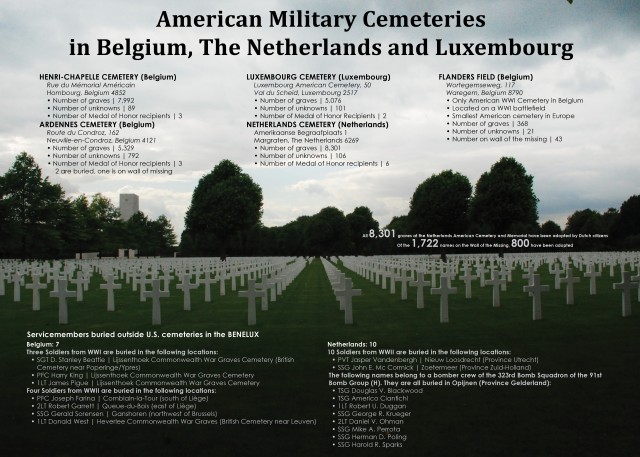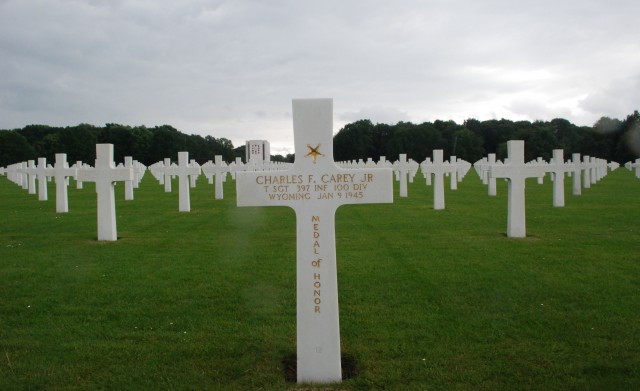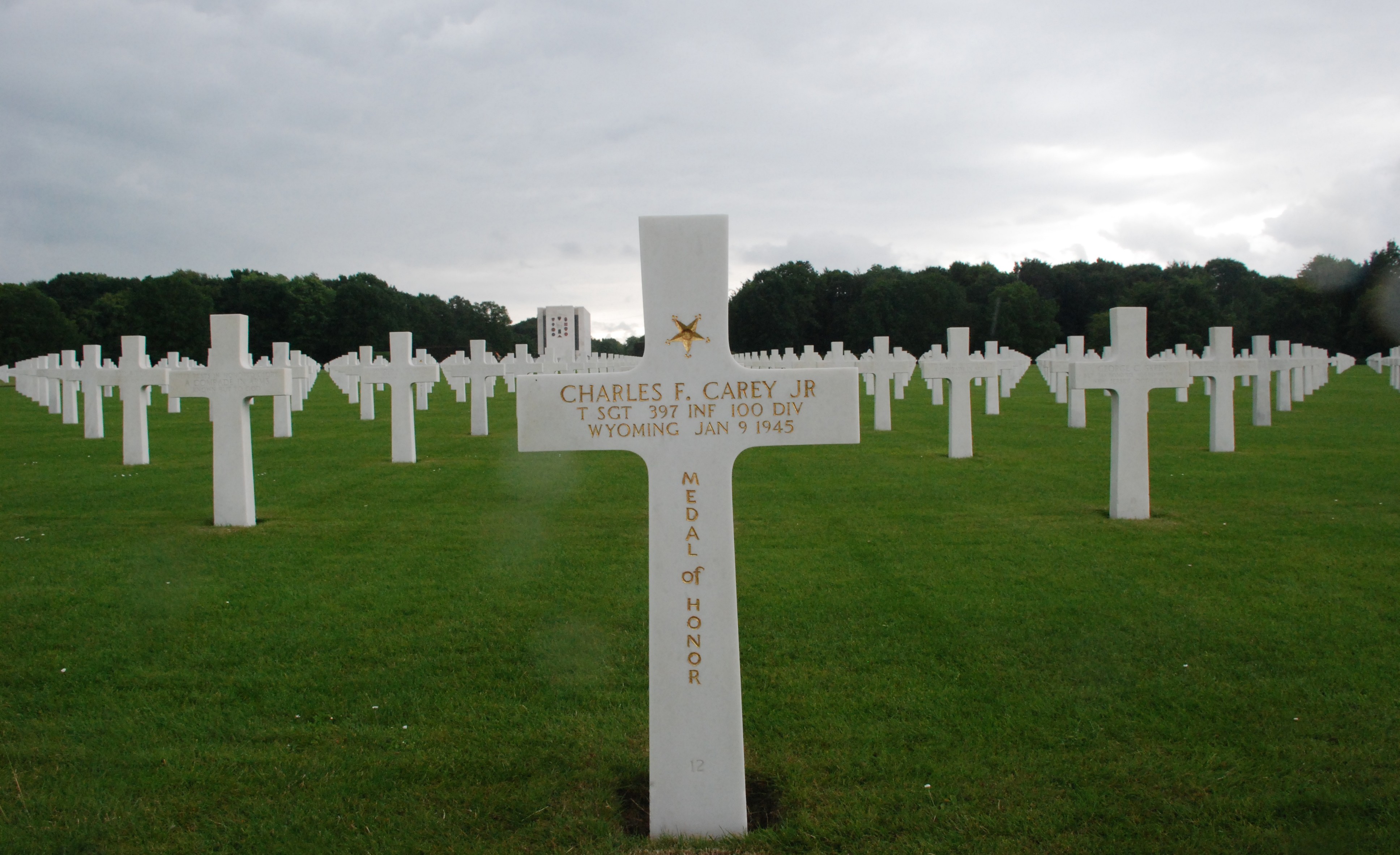The places where they lie are solemn and reverent, designed to pay tribute to the men and women of the United States who traveled to a foreign country to take part in two world wars and ended up giving the ultimate sacrifice. The numbers of war dead speak for themselves. Overall, almost 125,000 Americans remain in cemeteries on foreign soil. They fell in a number of different conflicts and lie in cemeteries across Europe, Africa and the Pacific. Five such American cemeteries are located in the Benelux footprint and are not only a lasting memorial to the men and women who rest there, but they are also a link that binds the military of today to the military of yesterday.
In Belgium alone there are three cemeteries. Two cemeteries contain the remains of World War II dead and one cemetery contains the remains of World War I casualties. The Netherlands and Luxembourg are also host countries to a WWII American military cemetery. Each cemetery has its own story, just as each has its own layout, but they all share the common goal of paying respect and tribute to the thousands of Soldiers, Sailors, Marines and Airman who fell in battle and remain in a foreign land today.
The largest cemetery within the Benelux footprint is the Netherlands American Cemetery and Memorial in the Netherlands. 8,301 Servicemembers are buried there and 1,722 names are listed on the tablets of the missing. Henri-Chapelle American Cemetery and Memorial in Belgium contains the graves of 7,992 Servicemembers, as well as, the names of 450 missing. The Ardennes American Cemetery and Memorial, also in Belgium, contains the remains of 5,329 military dead and lists the names of 462 of the missing. And the Luxembourg American Cemetery and Memorial, in Luxembourg, contains the graves of 5,076 fallen Servicemembers in addition to the names of 371 of the missing. Just within the Benelux footprint, there are well over 29,000 World War II dead.
The people behind those numbers are what complete the picture. "These are not just marble headstones, these are people," said Frenk Lahaye, a cemetery associate at the site in the Netherlands.
All four of the World War II cemeteries started as temporary cemeteries. "Right after the war, there needed to be places to identify the casualties," said Michael Green, superintendent of the Ardennes cemetery.
The Ardennes was an official identification station, as well as, a temporary cemetery. At the end of the war, approximately 11,000 Servicemembers were buried in what is now the site of the Ardennes cemetery. The cemetery in the Netherlands was at one point the largest American cemetery in Europe. After the war ended, almost 18,000 American men and women rested there.
Some cemeteries also housed the remains of German Soldiers who were later repatriated to their home country. The same was true at Henri-Chapelle cemetery, where the remains of almost 17,000 Servicemembers were buried at the end of the war.
In the years following, the U.S. government gave families who had loved ones in overseas cemeteries the option of leaving them there permanently or having them disinterred and sent home.
"At the end of the war, there were over 400 different temporary cemeteries. When the families were given the choice of having their loved ones returned, over 60 percent said bring them home," said Green.
For the Servicemembers who remained behind, the American Battle Monument Commission took over, providing a hallowed ground for them to rest and a place where visitors could pay their respects and gain insight into the lives of the men behind the names on the headstone.
When visitors come to the office of the Henri-Chapelle Superintendent, Alvin Nagel, he pulls out a book full of documents, letters, pictures, telegrams and other mementos sent to the cemetery by family members or friends of the deceased.
Only a fraction of the names are represented by a personal item but Nagel hopes that the book continues to expand. "We've requested families to send us information, if possible, letters or pictures. We keep these on permanent record. The idea is to put a face on every Soldier," he said.
That's something that Green echoed. If someone stops by the Ardennes information center he will make every effort to escort them around the grounds, explaining the personal stories of various men spread across the 90 acres, as well as, facts behind the construction of the cemetery, the statue on the grounds and the chapel.
He escorts guests to the grave where 13 unknowns are buried together. Their landing craft sank during the Normandy campaign, and they were interred together. He walks visitors to the graves of the Calo brothers, Pfc. Richard Calo, who was killed during the invasion of Normandy in 1944, and Cpl. Oswald Calo, who died almost one year later. They now rest side-by-side in a peaceful location near the middle of the Ardennes cemetery.
All four cemeteries contain several sets of brothers buried side-by-side. The Netherlands cemetery has 40 pairs of brothers, Luxembourg has 22 pairs and one set of close friends, who were buried next to each other at the request of their families, and Henri-Chapelle has 36 pairs of brothers and one set of three brothers who rest side by side.
In the various cemeteries, there are men who also have ties to the USAG Benelux, including Sgt. Louis Colwart, Jr., a crewmember on the B-17 "Susan Ruth" which crashed in the Chimay region in February 1944. Colwart was killed at the site and is remembered yearly by Dr. Paul Delahaye and a dedicated group of Belgian townspeople and attendees from USAG Benelux. Another crew member, Sgt. John Pindroch, rests at Margraten. He survived the plane crash but was executed several months later by Soldiers of the Third Reich.
Seven men who were part of the "Wereth 11" are buried in various locations at Henri-Chapelle cemetery. The men were massacred in the St. Vith area in 1944 by Nazi Soldiers. The graves of the seven have been adopted by the USAG Benelux and each Memorial Day special attention is paid to their graves. The certificates of adoption are one of the first things visitors see when they enter the front doors of Building 30 on Caserne Daumerie.
While each headstone and name of the missing marks an important person in their own right, there are also the famous amongst the buried and missing. Spread across the four WWII cemeteries, there are 14 Medal of Honor recipients. In the Netherlands cemetery alone, there are six men who were awarded the Medal of Honor, and arguably one of the most recognizable names in the Army, Gen. George Patton, is buried in the cemetery in Luxembourg.
But each man and woman in the five cemeteries, no matter what their story is, continues to do a job they started more than sixty years ago according to Green. "They're all still on duty, reminding the world what they did," he said.
The garrisons across the Benelux footprint have supported the regional cemeteries over the years with color guard formations, honor platoons, visits, tours and volunteers who help honor the memories.
For 2009 Memorial Day events at Henri-Chapelle cemetery, members of the Better Opportunities for Single Soldiers program and other volunteers spent the day at the cemetery, preparing for theceremony by placing an American and a Belgian flag in front of each headstone.
Sgt. Kyle Hagen, a USAG Benelux Soldier helped plan the trip, which was dedicated to the memory of the fallen. "It was an honor. Those Soldiers died for us, so we would be free from tyranny," he said.
The cemeteries see some of their largest crowds around Memorial Day each year, but that is just one piece of what services they provide. Nagel said providing support to the families who visit is one of the most crucial parts of the cemetery staffs jobs.
"Our main mission is to take care of the families who visit loved ones. We take the family to the grave. We have some sand here from Normandy and we use that to highlight the letters on the headstone. Then we provide the next of kin with a photograph," said Nagel.
The same scene is repeated at the Ardennes cemetery. Green said, over the years, staff members have tried different types of sand as a way to highlight the letter so they stand out from the all white marble markers, but the Normandy sands have the perfect texture and color. He said nothing else seems to work, as well.
In addition to family and friends of the deceased, tourists and local residents make their way to the American cemeteries throughout the year. "People should visit these cemeteries because the life they have today is because of these Soldiers. The motto of the American Battle Monuments Commission is 'Time will not dim the glory of their deeds.' Not only do we want people to remember, but we want them to pass this onto their kids," Nagel said.
Each cemetery has its own special ties with the local community around it, but one of the most striking examples of this is at the Netherlands Cemetery. All of their graves in the cemetery are adopted by a local person or family. Many of the names of the missing have also been adopted.
"Right after the war, in 1946, there were many Soldiers in Germany, and they would come and visit their family or their buddies here. They started to ask the local residents to bring flowers to certain graves or say a prayer on Christmas or a birthday or other special days," said Lahaye.
Local residents were more than willing to assist and even formed a committee with the goal of making sure each grave in the cemetery had someone who would visit it and commemorate special events. Within a year, all the graves were adopted.
"They did this out of gratitude for the men and women who paid the ultimate price but they also understood that it was sometimes difficult for friends and family to come here and visit," said Lahaye. Many times the adoptive Dutch families formed lasting relationships with the American families of the dead.
Lahaye added with pride, "This is really a very special aspect of our cemetery. It is very rooted in the community. Sometimes we see the third generation of a family who has adopted a grave and passed this down in their family. It makes us very proud to see that."
Regardless of where the American Servicemember or civilian rests, the cemetery staff urges visitors to come out and see the sites first-hand and learn about the people who paid for freedom with their lives. "Each and every headstone and name has an important story. It's a person who gave their life and left behind a family in grief," said Lahaye.
The different cemetery staff members say that each visitor takes away something different, but it is the fact that they visit and honor those who rest in the cemeteries that truly speaks volumes.
"One of the most important things we can remember is that they were in the prime of their lives, and they sacrificed theirs so that we might have ours. They are our legacy," said Green as he concluded a tour with one set of visitors and moved on to welcome the next couple who had walked in the door of the Ardennes visitor center and begin the whole process again.




Social Sharing